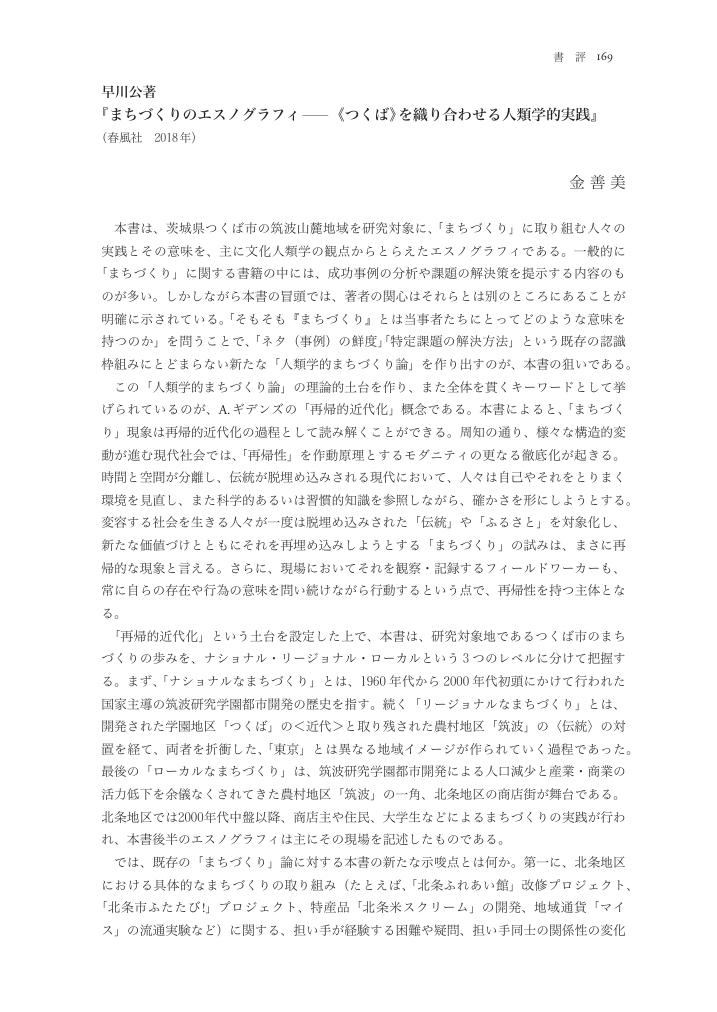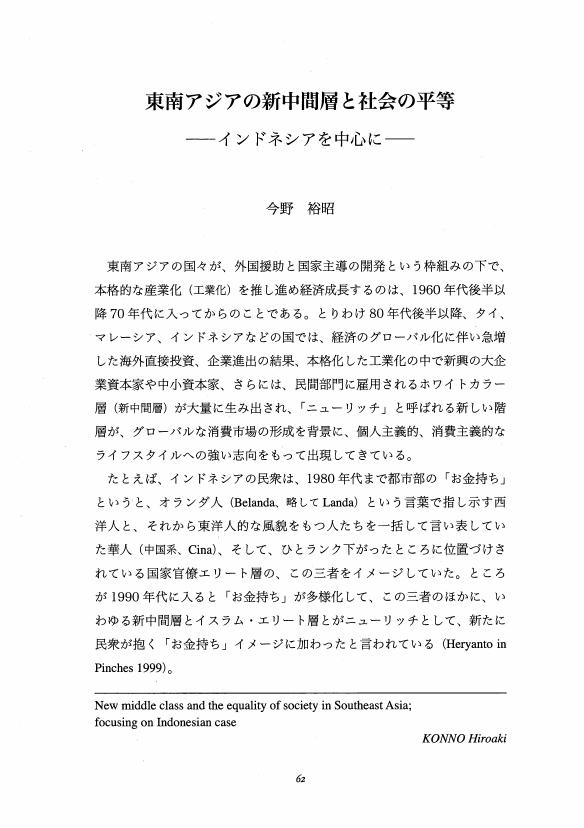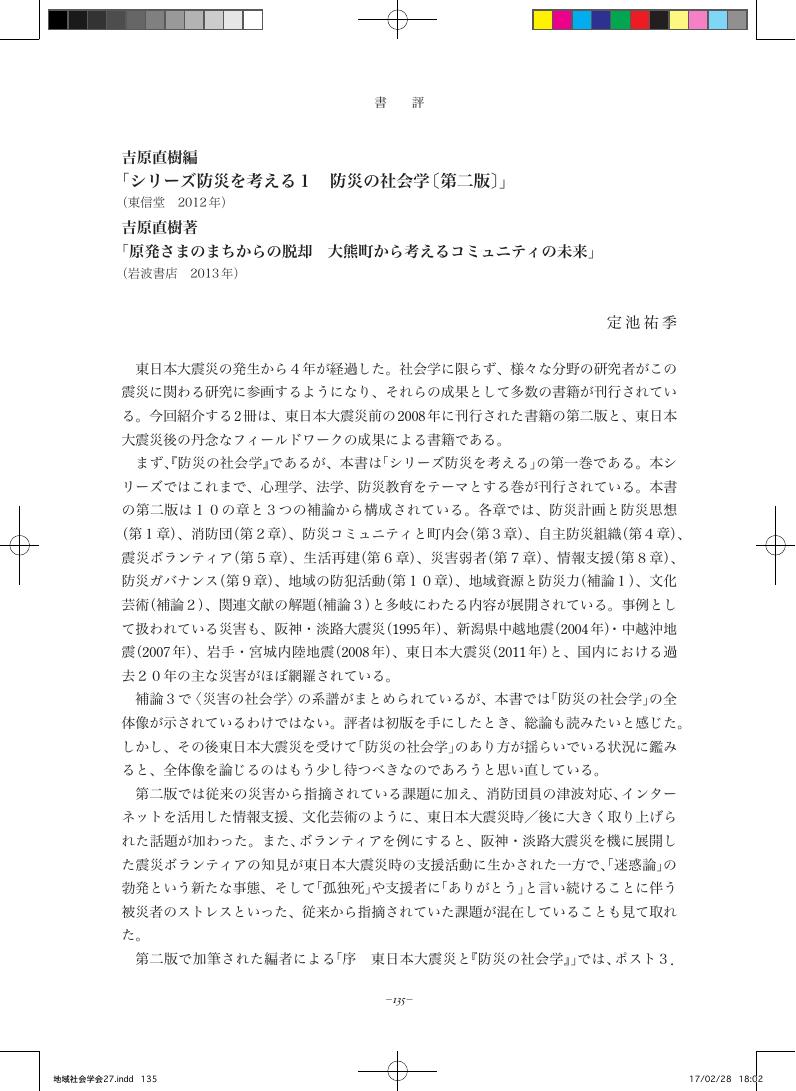- 著者
- 金 善美
- 出版者
- 地域社会学会
- 雑誌
- 地域社会学会年報 (ISSN:21893918)
- 巻号頁・発行日
- vol.32, pp.169-170, 2020-05-25 (Released:2021-11-26)
1 0 0 0 OA 東南アジアの新中間層と社会の平等 ──インドネシアを中心に──
- 著者
- 今野 裕昭
- 出版者
- 地域社会学会
- 雑誌
- 地域社会学会年報 (ISSN:21893918)
- 巻号頁・発行日
- vol.18, pp.62-78, 2006-05-14 (Released:2021-05-07)
- 参考文献数
- 22
1 0 0 0 OA 林 真人著 『ホームレスと都市空間―収奪と異化、社会運動、資本‐国家』 明石書店
- 著者
- 山本 崇記
- 出版者
- 地域社会学会
- 雑誌
- 地域社会学会年報 (ISSN:21893918)
- 巻号頁・発行日
- vol.27, pp.145-146, 2015 (Released:2017-07-03)
- 著者
- 中澤 秀雄
- 出版者
- 地域社会学会
- 雑誌
- 地域社会学会年報 (ISSN:21893918)
- 巻号頁・発行日
- vol.15, pp.44-61, 2003-10-05 (Released:2021-05-07)
- 参考文献数
- 31
- 著者
- 齊藤 康則
- 出版者
- 地域社会学会
- 雑誌
- 地域社会学会年報 (ISSN:21893918)
- 巻号頁・発行日
- vol.28, pp.61-75, 2016 (Released:2017-05-15)
- 参考文献数
- 16
- 被引用文献数
- 2
In regional and community studies, there have been many researches about communities in temporary housing since the 1995 Great Hanshin-Awaji Earthquake. Sociologists, focusing on the period when disaster victims moved into prefab temporary housing, discussed the organization of tenants’ associations and support networks of volunteers. In contrast, they paid little attention to the development of these associations and networks. As the evacuation period is prolonged, victims not only live in temporary housing but also come to settle in the very area where it is located. This point seems to be lacking in existing sociological studies. In the 2011 Great East Japan Earthquake, more than 52,000 prefab temporary housing units were built in three disaster-stricken Iwate, Miyagi, and Fukushima Prefecture. The government of the day tried to move each disaster-hit community into each temporary housing complex in order to avoid harming pre-disaster neighborhood relationships. However, owing to the widespread evacuation, those who have different local backgrounds and various disaster situations separately moved into the same temporary housing especially in urban areas they flowed into. Moreover, such an organization policy from the government might have influence on their autonomous activities. Based on the above, this paper takes up a temporary housing complex “Asuto Nagamachi Kasetsu Jutaku” in Sendai-City, which many victims separately moved into. In this complex, people met with some neighbor problems in the beginning, but worked out health support activities and made a proposal of disaster public housing with aid from nonprofit organizations and professional volunteers. This study focuses on the transformation of their life problems and support networks by four time periods: moving into temporary housing, making relationships between victims, doing autonomous activities, and moving from temporary housing.
1 0 0 0 OA 都心居住とその社会的矛盾 リスケーリング戦略を現場から問いなおす
- 著者
- 丸山 真央
- 出版者
- 地域社会学会
- 雑誌
- 地域社会学会年報 (ISSN:21893918)
- 巻号頁・発行日
- vol.29, pp.13-26, 2017 (Released:2018-05-14)
- 参考文献数
- 44
- 被引用文献数
- 1
This article aims to illuminate contradictions between a state rescaling strategy as seen in the Grand Design of National Spatial Development toward 2050 and current conditions in targeted areas. Primarily, the article highlights metropolitan areas and the living conditions of urban residents. Through the strategic document, the Japanese government aspires to concentrate national resources in cities and metropolitan regions. In fact, since the late 1990s, many major Japanese metropolitan regions have expanded in terms of population; this trend is called re-urbanization. We distributed questionnaire surveys to apartment residents in the central cities of six metropolitan regions—Sapporo, Tokyo, Nagoya, Kyoto, Osaka, and Fukuoka. The data analysis revealed that a sizable number of residents enjoys a high occupational status and income stratum. These people are blessed further with material and cultural richness. Though many singles and couples enjoy abundance in the consumption environment of central cities, most families with young children are hard-pressed for time because of balancing work with family life. Therefore, they have few time to enjoy the rich cultural environment of the central city. On the one hand, many singles and couples have little interaction with their neighbors; on the other hand, many families with children build and maintain good neighborly relations as a catalyst for nurturing children. From the perspective of the geographical scalar debate, the state rescaling strategy—as seen in the Grand Design—has been developed considering inter-corporation and inter-urban economic competition on the global scale. However, the daily lives of urban residents, especially families with young children, are dependent on a neighborhood scale, not global scale. These scalar contradictions included in the state rescaling strategy might have worsened the living conditions of urban residents.
1 0 0 0 OA 「最後のヤマ」閉山離職者の再就職過程 太平洋炭礦と釧路地域
- 著者
- 嶋﨑 尚子 須藤 直子
- 出版者
- 地域社会学会
- 雑誌
- 地域社会学会年報 (ISSN:21893918)
- 巻号頁・発行日
- vol.25, pp.109-125, 2013 (Released:2018-05-14)
- 参考文献数
- 31
In 2002, Taiheiyo Colliery Co, Ltd., the last coal mine in Japan, closed, resulting in the unemployment of 1,600 people. Their re-employment was extremely difficult. The objective of this paper is to analyze how the characteristics of the last coal mine affected their subsequent careers, using longitudinal microdata of all miners who lost jobs due to the Taiheiyo closure. We can trace them for three years until they lost eligibility for unemployment insurance. We assume two factors for the difficulty in re-employment. First, the last colliery could not offer other mining jobs as had former mine closings, except one new small-scale mine, Kushiro Coal Mine Company, Ltd., (KCM). It was established under the 5-year project to actively transfer world-leading mining technology to Asian countries, so it could employ only 500 people. In addition, the local area centering on Kushiro did not have sufficient jobs to absorb these workers due to the recession. Second, while most miners at other mines lived in company housing, Taiheiyo had a unique welfare policy that promoted home ownership. It is said that this unique housing policy enabled Taiheiyo to survive until the last moment. Therefore, at the closure of the mine, 74% of the miners owned their houses and they preferred to stay and seek jobs in Kushiro. Of course, house ownership lightened the conditions for seeking jobs in Kushiro, but made miners hesitate to seek jobs outside Kushiro. Therefore, when Kushiro fell into recession, motivation to seek employment decreased, especially in the case of elderly. We conclude that the housing policy led to a dysfunction in re-employment
- 著者
- 渡戸 一郎
- 出版者
- 地域社会学会
- 雑誌
- 地域社会学会年報 (ISSN:21893918)
- 巻号頁・発行日
- vol.26, pp.169-170, 2014 (Released:2017-12-18)
1 0 0 0 OA 商店街組合におけるコミュニティ形成機能の創出
- 著者
- 伊藤 雅一
- 出版者
- 地域社会学会
- 雑誌
- 地域社会学会年報 (ISSN:21893918)
- 巻号頁・発行日
- vol.29, pp.89-102, 2017 (Released:2018-05-14)
- 参考文献数
- 18
This study explains the process of community formation through a shopping street union. I conducted a case study of the activities of a shopping street union. The data for the study were obtained through fieldwork and interviews conducted at the Sengen shopping street in the Inage Ward, Chiba City. In particular, my research focused on the Inage Akari Festival, Yotoboshi. I analyzed perspectives at three levels: (1) actions of shopkeepers who are the main members of the Yotoboshi executiv (actor level), (2) the relationship between various community groups and the shopping street union through the Yotoboshi management (group level), and (3) changing evaluations from outside the community through social policy and media (structure level). The following factors can be drawn with respect to the three points of view: (1) actor level: the time of the changing generation of shopkeepers in Inage shopping street promoting union, two inspection tours inspiring the union to know the role of the community actors, and understanding the Inage Akari Festival, Yotoboshi through collaboration between the university student group and the shopping street union, (2) group level: collaboration between several community groups and the shopping street union for the management of the festival and the achievement of the meaning of the festival as a community through collaboration and formation of multiple layers of members in the festival executive committee (residents in Inage area, groups of activity based in Inage area, and voluntary participation from outside the Inage area); (3) structure level: positive evaluations for community formed by various media and social policies, and reflexive internalization of the evaluation by core members of the festival’s executive committee (in particular, shopkeepers in the union). These factors contribute to regional and community studies by clarifying the process of community formation function through a shopping street union. Furthermore, these conclusions are key in studying the local commercial function that depends on the shopping street unions in Japan.
1 0 0 0 OA 「未発」の国家リスケーリング? 「世界都市」形成から「平成の大合併」へ
- 著者
- 町村 敬志
- 出版者
- 地域社会学会
- 雑誌
- 地域社会学会年報 (ISSN:21893918)
- 巻号頁・発行日
- vol.25, pp.49-60, 2013 (Released:2018-05-14)
- 参考文献数
- 14
- 被引用文献数
- 2
Does the state rescaling theory explain the historical change of spatial policies in Japan after rapid economic growth, and if so, to what extent? This article considers the political and spatial meaning of two major urban and regional policies in contemporary Japan, by using “rescaling” theory. One is Tokyo’s global city formation in 1980s, which was an early-born, competitiveness-oriented, urban locational policy, and the other is Heisei municipal mergers, which was a territorial readjustment at the local scale in 2000s. An analytical framework of state rescaling, certainly, contribute to further understanding how and why both national and local governments have attempted to rearticulate a relationship between space and society in various forms, to solve problems caused by Japan’s transition from economic growth to shrinking. Yet there are several questions to be considered. An explanatory power of state restructuring theory was based upon the growing importance of supra-national scale such as EU in Europe. An increasing flow of capital and labor among East Asian countries has given rise to a relatively bounded economic space also in this region, while it is still difficult to tell about a same scenario of state rescaling, as in Europe. A potential form of governance and its spatial manifestation should be considered.
- 著者
- 定池 祐季
- 出版者
- 地域社会学会
- 雑誌
- 地域社会学会年報 (ISSN:21893918)
- 巻号頁・発行日
- vol.27, pp.135-136, 2015 (Released:2017-07-03)
- 著者
- 有末 賢
- 出版者
- 地域社会学会
- 雑誌
- 地域社会学会年報 (ISSN:21893918)
- 巻号頁・発行日
- vol.26, pp.155-156, 2014 (Released:2017-12-18)






